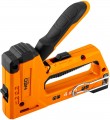Fastener type
—
Nail. Traditional nails are pointed rods with hats. However, hammers are often made for specific types of nails, and ordinary ones cannot be charged in them, this point in each case must be clarified separately. The nail is usually hammered in as a whole, right up to the head; such fasteners are tightly held in the material.
—
Staple. Colloquially, staples are sometimes referred to as "paper clips", although this is not entirely true. Such fasteners are familiar to many from ordinary stationery staplers, however, staples can also be used for more serious tasks — for example, attaching upholstery to wooden furniture. They do not hold as tightly as nails, but the oblong shape of the staple is in some cases a decisive advantage, and reliability is often enough.
—
Pin / hairpin. Fasteners that are driven in the same way as nails, but do not have expanded hats at the top. In addition, they differ somewhat in application: the pin can protrude above the surface of the material, or vice versa, be completely hidden inside, in such a way that then “mask” the fasteners with putty, decorative film, etc. All this requires specific design features, so not every stapler capable of using nails will be compatible with pins / studs.
Compatible staples
Staple models that the tool is compatible with.
Usually, quite specific options are indicated in this paragraph, so finding compatible consumables is not difficult. The specific dimensions of the fasteners should be specified according to the manufacturer's data — different brands use different markings.
Max. staple width
The largest width of staples (see Fastener Type) that the stapler can work with.
The width of the bracket is, roughly speaking, the distance between its legs. Different situations and types of work require different sizes of staples, and sometimes the width must be quite large. However, a staple that is too large simply will not fit into the store, not to mention the fact that the stapler can “shoot” it normally. Therefore, this limit cannot be exceeded, and if you plan to work with brackets, you should pay special attention to the maximum width when choosing.
Min. staple length
The smallest length of staples (see Fastener Type) that the stapler can work with.
The length in this case means the length of the leg — in other words, the depth to which the staple clogged "to the stop" penetrates into the material. Small staples do not require much power to drive, but the tool may not be designed for fasteners that are too short due to other parameters — for example, the design of the magazine. Therefore, for many models, this limitation is quite relevant, and in powerful professional models, the minimum length can be quite large — more than 20 mm.
Min. nail diameter
The smallest thickness of nails (see "Type of fastener") that the stapler can work with.
A nail that is too thin is just as undesirable for a tool as one that is too thick: already in the store, such parts can hang out, and there is no question of correct “shooting” at all. Therefore, this limitation should definitely be taken into account when choosing, especially if you plan to work with nails of small thickness. The most "thin" modern staplers have a minimum limit of about 1 mm, and in professional models it can exceed 2.5 mm and even 3 mm.
Max. nail diameter
The largest thickness of nails (see "Type of fastener") that the stapler can work with.
Thick nails require not only the appropriate size of the magazine and feeder, but also significant effort is required to drive them. Therefore, the larger the maximum allowable nail diameter, the more powerful, heavier and more expensive the tool, usually. Professional pneumatic nailers can be compatible with fasteners of 3.5 mm or more, but for entry-level tools, a thickness of 1.2 — 1.5 mm is often more than enough.
Min. nail length
The shortest length of nails (see Fastener Type) that the stapler can handle.
The shorter the fastener, with the same thickness, the less effort is required to drive it, but a nail that is too short simply cannot stand under impact normally. Therefore, for many instruments, this restriction is directly indicated. It is worth paying attention to it first of all if you plan to work with small short nails.
Max. nail length
The longest length of nails (see Fastener Type) that the stapler can handle.
With the same thickness, a longer nail requires not only the appropriate space in the magazine and feed mechanism, but also a higher impact energy — otherwise it simply will not work to hammer it “on the head”. This means that the maximum fastener length is directly related to the power and, accordingly, the overall level of the tool. Recall that a powerful professional tool has the appropriate dimensions and weight, moreover, it is often made pneumatic (for more details, see "Type"). Therefore, it makes sense to look for models that are compatible with long nails only if this is critical for the planned work.
Min. pin thickness
The smallest diameter of the attachment pin (see Attachment Type) that the stapler can handle.
The tool cannot effectively capture a workpiece that is too thin, and, accordingly, effective clogging is out of the question. However this limitation can be so small that it can be neglected — in particular, because such thin pins for general use are simply not produced. Therefore, the minimum pin diameter is indicated relatively rarely, and mainly in cases where it exceeds 0.5 mm.



